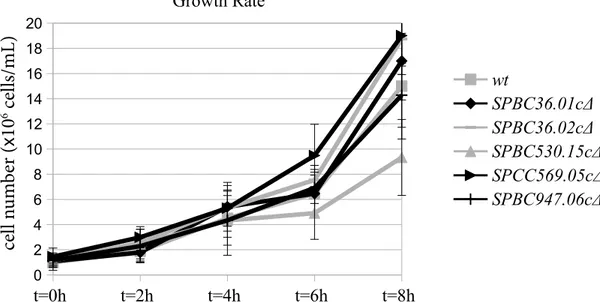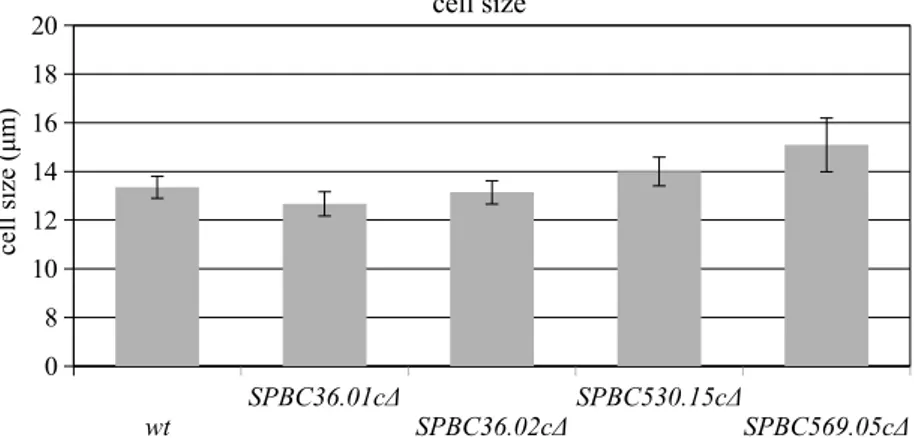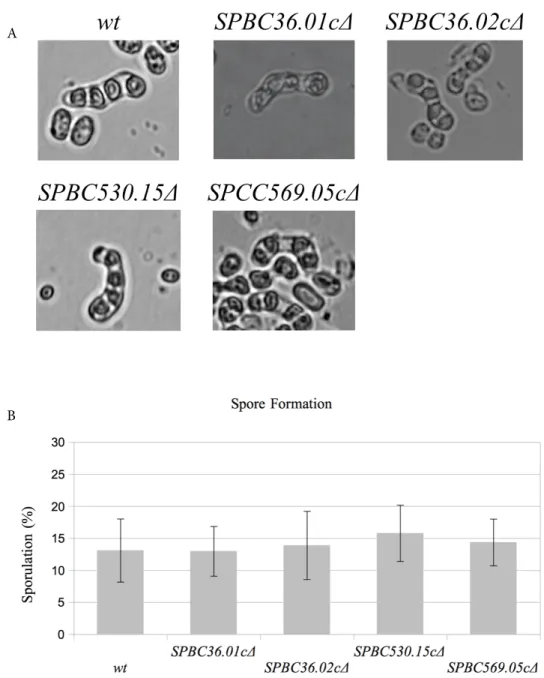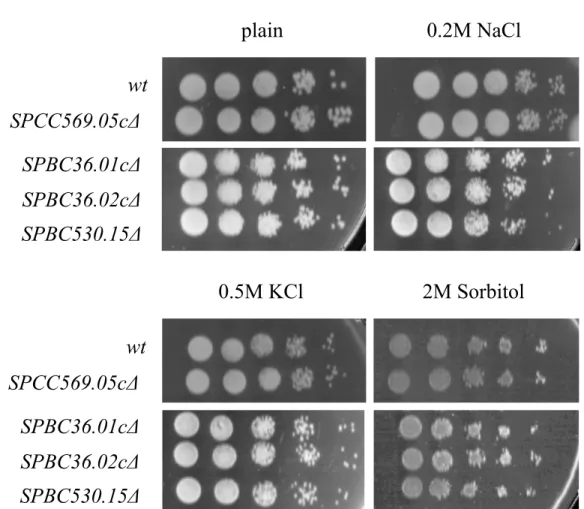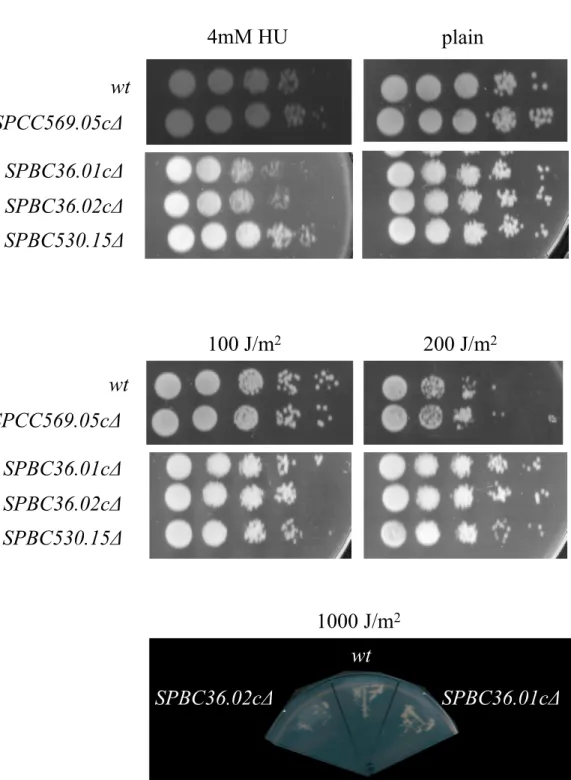http://journals.tubitak.gov.tr/biology/ © TÜBİTAK
doi:10.3906/biy-1608-70
The role of predicted spermidine family transporters in stress
response and cell cycle in Schizosaccharomyces pombe
Aslıhan ÖRS GEVREKCİ*
Department of Psychology, Faculty of Science and Letters, Başkent University, Ankara, Turkey
1. Introduction
Polyamines (spermidine, spermine, and putrescine) are small organic molecules with amine groups that are well conserved in different organisms. They exist in all living species except the Archaea, Methanobacteriales, and Halobacteriales (Hamana and Matsuzaki, 1992). They are involved in multiple functions in the cells, such as cell growth, differentiation, cell cycle, apoptosis, stress response, and cell survival (Schipper et al., 2000; Wallace et al., 2003; Liu et al., 2007). At physiological pH polyamines are positively charged, which enables their interaction with DNA. Spermidine and spermine form a bridge between the minor and major grooves of DNA and influence the structure and function of the DNA (Hampel et al., 1991; Roberts et al., 1992; Matthews et al., 1993), which is the reason why polyamine depletion results in partial unwinding of DNA. They can also regulate transcription of genes such as c-myc (Celano et al., 1992).
Polyamines are mostly studied in plants and they are known to be especially important in surviving stress conditions, such as UV irradiation or drought (Kusano et al., 2007; Liu et al., 2007). As shown in a number of studies, polyamines are also involved in cell cycle regulation
in multiple cells; hence, depletion of polyamines or inhibition of the biosynthetic pathway leads to cell cycle defects (Fredlund and Oredsson, 1996; Ray et al., 1996; Choi et al., 2000; Igarashi and Kashiwagi, 2010). For instance, in fission yeast Schizosaccharomyces pombe, lack of spermine and spermidine leads to cell cycle defects (Russell et al., 1975). Due to their extensive effects on cell survival, polyamine inhibitors are even thought to be candidate agents in the prevention of cancer (Casero and Marton, 2007; Nowotarski et al., 2013). Consistent with this, there is also evidence that polyamine overproduction and polyamine metabolism dysregulation are associated with many different forms of cancer and their metastatic properties (Casero and Marton, 2007; Soda, 2011).
Since polyamines are involved in so many processes, polyamine metabolism is strictly regulated in the cells (Cohen, 1998). Redundant mechanisms have evolved to ensure polyamine homeostasis, such as regulation of polyamine synthesis and transport of polyamines into and out of the cells by specific transporters. Polyamine transport is sensitive to the growth rate of cells. Polyamine export out of the cell is turned on by decreased growth rate and turned off in response to growth stimuli, such as
Abstract: Fission yeast Schizosaccharomyces pombe has a variety of stress-signaling proteins that protect cells against environmental or intracellular stress. These proteins help the cells to respond to stress conditions and regulate intracellular functions such as cell division or gene expression. Polyamines (spermidine, spermine, and putrescine) are known to be important in the regulation of stress response and cell division. In this study, we tried to experimentally characterize novel S. pombe genes that are involved in the polyamine pathway and understand their potential roles. Sequence analysis revealed four genes that code for (predicted) spermidine family transporters in S. pombe. In an attempt to characterize these (predicted) spermidine family transmembrane transporters and their possible roles, deletion mutants of these candidate genes were created. These mutants were exposed to different stress conditions, such as DNA-damaging agents and osmotic stress, to understand their significance in the stress response. Next, the mutants were analyzed in terms of cell size, growth rate, and spore formation to understand their contribution to cell cycle control. The results revealed that individual deletion of two of these genes, SPBC36.01c and SPBC36.02c, resulted in sensitivity to DNA-damaging agents, indicating their role in DNA damage response.
Key words: Polyamines, spermidine, Schizosaccharomyces pombe, cell cycle, stress response
Received: 23.08.2016 Accepted/Published Online: 15.12.2016 Final Version: 14.06.2017 Research Article
serum and nutrients (Wallace and Keir, 1981; Wallace and Mackarel, 1998). There are further feedback mechanisms to control polyamine levels in the cell such that increased polyamine levels lead to an increase in antienzyme 1 in mammalian cells, which negatively regulates the synthesis and uptake of polyamines (Rom and Kahana, 1994; Gesteland et al., 1999). This negative feedback loop keeps the polyamine levels constant in cells. A similar negative feedback loop also exists for P. polycephalum, S. cerevisiae,
N. crassa, and S. pombe (Mitchell and Wilson, 1983;
Williams et al., 1992; Toth and Coffino, 1999; Ivanov et al., 2000).
The S. pombe genome has been completely sequenced and there are a number of genes that await experimental characterization. Four of these genes, SPBC36.01c,
SPBC36.02c, SPBC530.15c, and SPCC569.05c, are named as
predicted spermidine family transmembrane transporters based on sequence similarity. They share major facilitator superfamily domains. The S. pombe database PomBase was used to obtain the sequences of these uncharacterized/ predicted spermidine family transporters. There are very limited experimental data on these uncharacterized genes. In a microarray-based study, cells that are made cisplatin-resistant upon chronic exposure to the drug showed decreased SPCC569.05c gene expression (Gatti et al., 2004). Another study showed that in a genome-wide scan, SPBC36.01c protein tagged with GFP was localized on the membrane. This is consistent with the transmembrane segment sequence, which is predicted in sequence analysis. This study tried to further characterize four of the predicted spermidine family transporters and reveal their potential roles in stress response and cell cycle regulation.
2. Materials and methods 2.1. Yeast strains and media
The methods for handling S. pombe were as described by Moreno et al. (1991). Strains used in this study were 972 (h- ade) and 975 (h+ ade). YEA medium (5 g/L Difco yeast
extract, 30 g/L glucose, 75 mg/L adenine, pH adjusted to 5.6 with HCl) was used to incubate cells. Agar medium contained 2% agar (w/v). Tenfold serial dilutions (starting from 5 × 104 cells until 5 cells) were spotted out on the
medium in aliquots of 8 µL and incubated at 30 °C for 3–5 days. To induce sporulation, the cells were then incubated on SPA low-nitrogen medium (1 g/L KH2PO4, 10 g/L glucose, 1 mL/L 10,000X vitamin stock solution (10 g/L pantothenate, 100 g/L nicotinic acid, 100 g/L inositol, 100 mg/L biotin)) for 5 days at 25 °C.
2.2. Gene deletion in S. pombe
A PCR-based gene targeting method (Bähler et al., 1998) was used for constructing gene deletion. pFA6a-kanMX6
(Bähler et al., 1998) and pFA6a-hphMX6 (Sato et al., 2005) plasmids carrying kanamycin and hygromycin resistance genes, respectively, were used to replace the gene that would be deleted. The cells were initially incubated in a medium containing 200 mg/L G418 to select for the kanamycin resistance gene and 300 µg/mL hygromycin to select for the hygromycin resistance gene. The cells that could survive on selective media with antibiotics were checked with colony PCR according to whether they had the antibiotic resistance cassette in the right place.
2.3. Confirmation of the mutants by colony PCR
Colony PCR was performed to make sure the deletion cassette was integrated into the correct location. The forward primer was designed for the cassette and the reverse primer for the downstream region of the gene. The colonies were initially boiled with the dNTP mix, PCR buffer, and primers at 98 °C for 10 min. Taq polymerase was added after the mixture had been cooled down. The PCR program was as follows: 30 cycles at 94 °C for 20 s, 50 °C for 40 s, and 72 °C for 1 min/kb.
Deletion mutants of (predicted) spermidine family transporter genes are as follows (mating type, antibiotic cassette): SPBC36.01c (h+, hygromycin), SPBC36.02c (h-,
kanamycin), SPBC530.15c (h-, kanamycin), SPCC569.05c
(h+, hygromycin).
2.4. Lithium acetate (LiOAc) method of transformation in S. pombe
S. pombe cells were grown in 100 mL of YEA medium,
O/N at 30 °C until they reached 0.5–1 × 107 cells/mL. The
cells were then centrifuged down at 4000 rpm for 2 min. The pellet was washed with 50 mL of ddH2O and then with 1 mL of 0.1 M LiOAc (pH 4.9). After washing, cells were incubated in 2 mL of 0.1 M LiOAc (pH 4.9) at RT for 1 h. Following incubation, cells were centrifuged down at 4000 rpm for 2 min. The pellet was resuspended in 150 µL of 0.1 M LiOAc (pH 4.9) and incubated with 100 ng of DNA (the deletion cassettes) and 350 µL of 50% polyethylene glycol for 1 h at RT. Following incubation, 58 µL of DMSO was added and the cells were heat-shocked at 42 °C for 5 min. The cells were allowed to cool to RT for 10 min and centrifuged at 4000 rpm for 2 min. The pellet was washed with 1 mL of ddH2O and recentrifuged. Finally, the pellet was resuspended in 100 µL of ddH2O and plated on the agar medium with the nutritional supplement (YEA). After an incubation period of 24 h at 30 °C, the cells were replica-plated onto selective agar medium with the antibiotics.
2.5. Stress protocol
In order to reveal any defect in the stress response, S. pombe cells were initially grown in 50 mL of YEA medium, O/N
at 30 °C until they reached 0.5 × 107 cells/mL. They were
then plated onto YEA agar containing 4 mM hydroxyurea, 0.5 M KCl, 0.2 M NaCl, or 2 M sorbitol. The cells were plated onto the corresponding agar in 10-fold serial dilutions starting from 5 × 104 cells until 5 cells. For the
UV-dependent DNA damage response, however, the cells were plated onto YEA agar plates and they were exposed to UV irradiation right away. The cells were then incubated at 30 °C for 3–5 days.
3. Results
3.1. Verification of deletion mutants
Predicted spermine family transporters were selected from the PomBase website (http://www.pombase.org). Based on sequence similarity, SPBC36.01c, SPBC36.02c,
SPBC530.15c, and SPCC569.05c were identified as
predicted spermidine family transporters in PomBase. To characterize these genes experimentally, deletion mutants were generated and verified by first planting the cells on antibiotic-containing media and then colony PCR.
3.2. Growth rate analysis
The deletion mutants were first compared to the wild-type cells in terms of growth rate at the optimum conditions (YEA agar plate, 30 °C). A time course experiment was conducted to find out any defect in cell growth. To this end, wild-type and deletion mutant cultures were prepared at a density of 106 cells/mL and cell numbers were analyzed
every 2 h. The cell numbers were compared using a two-tailed Student’s t-test and no significant difference was observed between the doubling times of the wild-type cells and any of the deletion mutants. The results are shown in
Figure 1. To summarize, under optimum conditions, the mutants grow as well as the wild-type cells.
3.3. Cell size analysis
As a second step in the experimental characterization of the mutants, the cell sizes of all the deletion mutants were compared to wild-type controls. Previous work has shown that cell size could be an indicator of a cell cycle progression defect and abnormal cell size could be a result of a cell cycle regulator gene mutation. For instance, wee1 deletion results in shorter cell length, while cdc25 deletion results in elongated cells in S. pombe. Thus, in an attempt to understand the potential role of spermidine family transporters in cell cycle progression, the mutant and wild-type cells were grown in YEA liquid medium at 30 °C until they reached the log phase. The cells were analyzed under the microscope during their fast-growing phase to determine cell length. For each gene deletion and the control group, 40 individual cells were observed and statistically analyzed in this assay. A two-tailed Student’s t-test was performed to detect any statistically significant differences between the wild-type cells and the deletion mutants. Figure 2 shows the mean cell size values of the cells. The Table summarizes the mean values of the cell sizes, standard deviations (mean ± STD), 95% confidence interval upper and lower bounds, and P-values (computed in the 95% confidence interval). The results showed that the predicted spermidine family transporter SPBC36.01cΔ has a shorter cell size compared to wild-type cells.
3.4. Sporulation defect analysis
The S. pombe cell cycle is very sensitive to environmental conditions, which are mainly monitored at the G1 phase of the cell cycle. The cells are known to arrest at the G1
ce
ll n
um
ber (
x10
6ce
lls/mL)
Figure 1. Growth rate analysis of the wild-type (wt), SPBC36.01c∆, SPBC36.02c∆, SPBC530.15c∆, and SPCC569.05c∆ cells under optimum conditions.
phase in the case of environmental stress conditions, such as nutrient starvation. In this study, the nitrogen from the media (SPA medium) was depleted to induce G1 arrest. Upon G1 arrest, the wild-type cells mate with the cells of the opposite mating type, form diploid cells, and then go through meiosis to create spores. In this step, the deletion mutants were mixed with the wild-type cells of the opposite mating type and spore formation on SPA medium was observed after 3–5 days of incubation. No sporulation defect was observed in any of the four mutants (Figure 3A). The number of sporulations in each culture was also
checked, as shown in Figure 3B. The two-tailed Student’s t-test was performed to detect any statistically significant differences between the wild-type cells and the deletion mutants and no significant difference was observed. P-values computed in the 95% confidence interval were as follows: SPBC36.01cΔ (P < 0.51), SPBC36.02cΔ (P < 0.74),
SPBC530.15cΔ (P < 0.75), and SPBC569.05cΔ (P < 0.55). 3.5. Stress response analysis
Polyamines such as spermidine are well known to be involved in the stress response. Hence, we decided to check if the deletion of (hypothetical) spermidine family wt SPBC36.01cΔ SPBC36.02cΔSPBC530.15cΔSPBC569.05cΔ 0 8 10 12 14 16 18 20 cell size cell size (μm)
Figure 2. Cell size analysis of the wild-type, SPBC36.01c∆, SPBC36.02c∆, SPBC530.15c∆, and SPCC569.05c∆ cells. Error bars represent 95% confidence intervals.
Table. Cell size analysis.
Name of the gene
Mean cell size (µm) ± STD
P-value 95% confidence interval Lower bound Upper bound wt 13.35 ± 1.42 12.90 -13.81 SPBC36.01cΔ 12.66 ± 1.56 12.17 0.04 13.16 SPBC36.02cΔ 13.14 ± 1.50 12.66 0.63 13.61 SPBC530.15cΔ 14.00 ± 1.83 13.41 0.34 14.59 SPCC569.05cΔ 15.09 ± 3.44 13.98 0.58 16.19
transporter genes has any effect on the stress response. Two different types of stress were applied to the mutants as well as wild-type control cells. The first type of stress applied was environmental osmotic stress. Osmotic stress was induced by preparing YEA agar plates containing different amounts of KCl, NaCl, or sorbitol. Conditions (0.5 M KCl, 0.2 M NaCl, and 2 M sorbitol) are shown in Figure 4. As seen in Figure 4, under osmotic stress conditions, the deletion mutants did not show decreased viability. Higher concentrations of KCl (1 M), NaCl (1 M), and sorbitol (4 M) were used so that even wild-type cells stopped
growing, but no difference between the growth rates of wild-type cells and the mutants was detected. The second type of stress was induced by DNA-damaging agents. Two types of DNA damage were induced. The first was UV irradiation, which causes dimer formation in the DNA molecule, and the second one was hydroxyurea, which depletes dNTPs and stops DNA replication in the S phase. The same principle as osmotic stress was applied to DNA-damaging agents: UV exposure and hydroxyurea were increased until the wild-type cells stopped growing. In the case of hydroxyurea, two of the mutants, SPBC36.01cΔ and A
B
Figure 3. Spore formation in the wild-type (wt), SPBC36.01c∆, SPBC36.02c∆, SPBC530.15c∆, and
SPCC569.05c∆ cells (A) and sporulation efficiencies of the wt and mutant cells (B). Error bars represent 95% confidence intervals.
SPBC36.02cΔ, showed some sensitivity so that the cells grew less than the wild-type cells (Figure 5A). In the case of UV irradiation, however, out of the five mutants only
SPBC36.01cΔ showed sensitivity (Figure 5B). 4. Discussion
Monitoring and responding to environmental and intracellular stress is crucial for the survival of cells. The cell cycle, along with many other intracellular metabolic pathways, is regulated according to the nature of the stress and thus there are proteins that connect these two processes in the cells (Petersen and Hagan, 2005; Ors et al., 2009; Majumdar et al., 2012). Polyamines have long been known for their roles in cell cycle regulation and stress response in different organisms. They are also reported to be involved in apoptosis and gene expression (Schipper et al., 2000; Krüger et al., 2013). Since polyamines are so important in many different processes, polyamine metabolism is kept under strict regulation in the cells. Interconversion and de novo synthesis of polyamines as well as their uptake by specific transporters contribute to the regulation of polyamine metabolism.
S. pombe is one of these organisms in which polyamines
are important for proper cell cycle progression. In a previous study, SPBC409.08 (predicted spermine family transporter) was involved in the cell cycle and SPAC9.02c (predicted polyamine N-acetyltransferase) was involved in the DNA damage response (Güngör and Örs Gevrekci, 2016). This encouraged us to examine predicted polyamine transmembrane transporters further. In this study, four candidate genes were identified, which confer sequence similarity to spermidine family transporters: SPBC36.01c,
SPBC36.02c, SPBC530.15c, and SPCC569.05c. Deletion
mutants of these genes were analyzed to reveal potential roles in cell cycle and stress response.
SPBC530.15c and SPCC569.05c gene deletions showed
similar phenotypes with the wild-type cells in our analysis. There was no significant difference in cell size. They could properly form spores, which indicates that mating and meiosis could proceed successfully in these mutants. When exposed to stress conditions such as increased salt concentration, UV irradiation, or hydroxyurea treatment, these mutants were no more sensitive than the wild-type cells. One explanation for that could be the fact
SPBC36.01c
SPBC530.15
SPCC569.05c
SPBC36.02c
wt
0.2M NaCl
0.5M KCl
2M Sorbitol
plain
SPBC36.01c
SPBC530.15
SPCC569.05c
SPBC36.02c
wt
Figure 4. Osmotic stress response of the mutants compared to wild-type cells (wt), under different concentrations of 0.2 M NaCl, 0.5 M KCl, and 2 M sorbitol.
that redundant mechanisms might exist for polyamine transport, so the effect is minimized.
One important effect was detected in SPBC36.01c deletion. The cell size of this mutant was shorter compared to wild-type cells, which was a small but statistically significant effect. The short cell size could be an indication of premature cell division, as in the case of wee1Δ (Nurse,
1975; Thuriaux et al., 1978). SPBC36.01cΔ cells were also detected to be sensitive to UV irradiation at very high exposures (1000 J/m2). The survival of the SPBC36.01cΔ
cells was also less than that of wild-type cells in the presence of hydroxyurea, which was a small but consistent effect. SPBC36.02c gene deletion was also slightly sensitive to hydroxyurea treatment. These results indicated a
SPBC36.01c
SPBC530.15
SPCC569.05c
SPBC36.02c
wt
4mM HU
SPBC36.01c
SPBC530.15
SPCC569.05c
SPBC36.02c
wt
plain
200 J/m
2100 J/m
21000 J/m
2wt
SPBC36.02c
SPBC36.01c
A
B
Figure 5. DNA damage response of the mutants compared to wild-type (wt) cells upon (A) hydroxyurea administration and (B) different exposures of UV irradiation.
potential role of the SPBC36.01c and SPBC36.02c genes in DNA damage response. A similar but much stronger effect was observed with the rad24 gene in S. pombe. rad24Δ cells were reported to be involved in the DNA damage checkpoint and they also entered mitosis prematurely (Ford et al., 1994), similar to SPBC36.01cΔ. The fact that SPBC36.01cΔ and SPBC36.02cΔ cells were sensitive to DNA-damaging agents is consistent with previous research, which showed that polyamines were involved in plant response to UV irradiation (Kusano et al., 2007). Polyamine synthesis and uptake is negatively regulated by antienzyme 1 upon increased polyamine levels (Gesteland et al., 1999; Niiranen et al., 2002). This negative feedback mechanism keeps the polyamine levels relatively constant in the cells. Consistent with this observation, an increase in polyamine levels could only be observed in the absence of antienzyme 1 (Ivanov et al., 2000). This phenomenon could be the reason why SPBC36.01cΔ and SPBC36.02cΔ mutants result in mild phenotypes in cell size or DNA damage sensitivity.
Polyamine transporters are involved in polyamine transfer in and out of the cell, regulate intracellular polyamine levels, and consequently contribute to stress response and cell cycle regulation. For instance, budding yeast polyamine transporter Tpo1 provides polyamine uptake at alkaline pH levels and induces polyamine export at acidic pH levels (Uemura et al., 2004). It exports polyamines upon stress and extends cell cycle arrest
induced by oxidants (Krüger et al., 2013). This study also showed that polyamine transporters are potential regulators of stress response and cell cycle.
To our knowledge, this study is the first experimental characterization of the SPBC36.01c and SPBC36.02c genes. These data extend the understanding of the polyamine metabolism players and roles in the cells. Polyamines have been of great interest due to their contribution to cancer progression and metastasis and their potential as therapeutic targets in human (Casero and Marton, 2007). Future extensions of this research involve a better understanding of the protein products of the SPBC36.01c and SPBC36.02c genes and their interaction partners and regulators. Any protein that physically interacts with the protein products of these genes reveals the potential regulators and highlights the pathways they contribute to. Therefore, tagged versions of these proteins can be used to hunt for physically interacting partners. Considering the wide range of activities that polyamines are involved in, we hope to find proteins related to other metabolic functions besides stress response and cell cycle to investigate as novel interacting partners.
Acknowledgment
This work was supported by TÜBİTAK (the Scientific and Technological Research Council of Turkey) under Grant No. 111T509.
References
Bähler J, Wu JQ, Longtine MS (1998). Heterologous modules for efficient and versatile PCR-based gene targeting in
Schizosaccharomyces pombe. Yeast 14: 943-951.
Casero RA, Marton LJ (2007). Targeting polyamine metabolism and function in cancer and other hyperproliferative diseases. Nat Rev Drug Discov 6: 373-390.
Celano P, Berchold CM, Kizer DL, Weeraratna A, Nelkin BD, Baylin SB, Casero RA Jr (1992). Characterisation of an endogenous RNA transcript with homology to the antisense strand of the human c-myc gene. J Biol Chem 267: 15092-15096.
Choi SH, Kim SW, Choi DH, Min BH, Chun BG (2000).
Polyamine-depletion induces p27Kip1 and enhances
dexamethasone-induced G1 arrest and apoptosis in human T lymphoblastic
leukemia cells. Leuk Res 24: 119-127.
Cohen SS (1998). A Guide to the Polyamines. New York, NY, USA: Oxford University Press.
Ford JC, al-Khodairy F, Fotou E, Sheldrick KS, Griffiths DJ, Carr AM (1994). 14-3-3 protein homologs required for the DNA damage checkpoint in fission yeast. Science 265: 533-535.
Fredlund JO, Oredsson SM (1996). Normal G1/S transition and
prolonged S phase within one cell cycle after seeding cells in the presence of an ornithine decarboxylase inhibitor. Cell Prolif 29: 457-465.
Gatti L, Chen D, Beretta GL, Rustici G, Carenini N, Corna E, Colangelo D, Zunino F, Bähler J, Perego P (2004). Global gene expression of fission yeast in response to cisplatin. Cell Mol Life Sci 61: 2253-2263.
Gesteland RF, Weiss RB, Atkins JF (1999). Recoding: reprogrammed genetic decoding. Science 257: 1640-1641.
Güngör İ, Örs Gevrekci A (2016). The roles of SPBC409.08 and SPAC9.02c hypothetical genes in cell cycle and stress response, in Schizosaccharomyces pombe. Cell Mol Biol 62: 42-47.
Hamana K, Matsuzaki S (1992). Polyamines as a chemotaxonomic marker in bacterial systematics. Crit Rev Microbiol 18: 261-283.
Hampel KJ, Crosson P, Lee JS (1991). Polyamines favour triplex DNA formation at neutral pH. Biochemistry 30: 4455-4459. Igarashi K, Kashiwagi K (2010). Modulation of cellular function by
polyamines. Int J Biochem Cell Biol 42: 39-51.
Ivanov IP, Matsufuji S, Murakami Y, Gesteland RF, Atkins JF (2000). Conservation of polyamine regulation by translational frameshifting from yeast to mammals. The EMBO Journal 19: 1907-1917.
Krüger A, Vowinckel J, Mülleder M, Grote P, Capuano F, Bluemlein K, Ralser M (2013). Tpo1-mediated spermine and spermidine export controls cell cycle delay and times antioxidant protein expression during the oxidative stress response. EMBO Rep 14: 1113-1119.
Kusano T, Yamaguchi K, Berberich T, Takahashi Y (2007). Advances in polyamine research in 2007. J Plant Res 120: 345-350. Liu JH, Kitashiba H, Wang J, Ban Y, Moriguchi T (2007). Polyamines
and their ability to provide environmental stress tolerance to plants. Plant Biotechnol 24: 117-126.
Majumdar U, Biswas P, Subhra Sarkar T, Maiti D, Ghosh S (2012). Regulation of cell cycle and stress response under nitrosative stress in Schizosaccharomyces pombe. Free Radic Biol Med 52: 2186-2200.
Matthews HR (1993). Polyamines, chromatin structure and transcription. BioEssays 15: 561-567.
Mitchell JL, Wilson JM (1983). Polyamine-stimulated alteration of the ornithine decarboxylase molecule in Physarum polycephalum. Biochem J 214: 345-351.
Moreno S, Klar A, Nurse P (1991). Molecular genetic analysis of fission yeast Schizosaccharomyces pombe. Methods Enzymol 194: 795-823.
Nowotarski SL, Woster PM, Casero RA Jr. (2013). Polyamines and cancer: implications for chemotherapy and chemoprevention. Expert Rev Mol Med 15: e3.
Nurse P (1975). Genetic control of cell size at cell division in yeast. Nature 256: 547-551.
Ors A, Grimaldi M, Kimata Y, Wilkinson CR, Jones N, Yamano H (2009). The transcription factor Atf1 binds and activates the APC/C ubiquitin ligase in fission yeast. J Biol Chem 284: 23989-23994.
Petersen J, Hagan IM (2005). Polo kinase links the stress pathway to cell cycle control and tip growth in fission yeast. Nature 435: 507-512.
Ray RM, Zimmerman BJ, McCormack SA, Patel TB, Johnson LR (1996). Polyamine depletion arrest cell cycle and induces inhibitors p21Waf7Cip1, p27Kip1, and p53 in IEC-6 cells. Am J
Physiol 276: 684-691.
Roberts RW, Crothers DM (1992). Stability and properties of double and triple helices: dramatic effects of RNA or DNA backbone composition. Science 258: 1463-1465.
Rom E, Kahana C (1994). Polyamines regulate the expression or ornithine decarboxylase antizyme in vitro by inducing ribosomal frame-shifting. P Natl Acad Sci USA 91: 3959-3963.
Russell DH, Durie BG, Salmon SE (1975). Polyamines as predictors of success and failure in cancer chemotherapy. Lancet 2: 797-799.
Sato M, Dhut S, Toda T (2005). New drug-resistant cassettes for gene disruption and epitope tagging in Schizosaccharomyces pombe. Yeast 22: 583-591.
Schipper RG, Penning LC, Verhofstad AA (2000). Involvement of polyamines in apoptosis. Facts and controversies: effectors or protectors? Semin Cancer Biol 10: 55-68.
Soda K (2011). The mechanisms by which polyamines accelerate tumor spread. J Exp Clin Cancer Res 30: 95.
Thuriaux P, Nurse P, Carter B (1978). Mutants altered in the control co-ordinating cell division with cell growth in the fission yeast
Schizosaccharomyces pombe. Mol Gen Genet 161: 215-220.
Toth C, Coffino P (1999). Regulated degradation of yeast ornithine de-carboxylase. J Biol Chem 274: 25921-25926.
Uemura T, Tachihara K, Tomitori H, Kashiwagi K, Igarashi K (2005). Characteristics of the polyamine transporter TPO1 and regulation of ıts activity and cellular localization by phosphorylation. J Biol Chem 280: 9646-9652.
Wallace HM, Fraser AV, Hughes A (2003). A perspective of polyamine metabolism. Biochem J 376: 1-14.
Wallace HM, Keir HM (1981). Uptake and excretion of polyamines from baby hamster kidney cells (BHK-21/C13): the effect of serum on confluent cell cultures. Biochem Biophys Acta 676: 25-30.
Wallace HM, Mackarel AJ (1998). Regulation of polyamine acetylation and efflux in human cancer cells. Biochem Soc Trans 26: 571-575.
Williams LJ, Barnett GR, Ristow JL, Pitkin J, Perriere M, Davis RH (1992). Ornithine decarboxylase gene of Neurospora crassa: isolation, sequence and polyamine-mediated regulation of its mRNA. Mol Cell Biol 12: 347-359.
